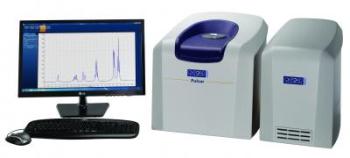May 3 2013
In a world first, scientists from the Institute of Food Research (IFR) on the Norwich Research Park have been test-driving a prototype instrument that promises to revolutionise access to a potent laboratory analysis technique called NMR (Nuclear Magnetic Resonance).
 This image shows Pulsar benchtop NMR. Credit: Oxford Instruments
This image shows Pulsar benchtop NMR. Credit: Oxford Instruments
The instrument was developed by Oxford Instruments, an award winning producer of scientific measuring equipment, who breathed new life into an existing technology using innovative designs and advanced electronics. The result is an NMR spectrometer called Pulsar.
Existing NMR spectrometers are hugely expensive, in part because they rely on special cooling, special housing and highly trained experts to run them. Pulsar, on the other hand, is a benchtop system based on permanent rather than superconducting magnets that is designed to work in an ordinary science lab and to be run by non-specialists.
Building on a long track record of scientific data analysis, the IFR team, led by Dr Kate Kemsley, are devising mathematical recipes and writing new computer software that will help to collect and analyse data from Pulsar automatically, without the need for experts to analyse the data a piece at a time. Making this partnership possible is funding from the Technology Strategy Board, who are sponsored by the Department of Innovation and Skills to stimulate technology-enabled innovation in the areas which offer the greatest scope for boosting UK growth and productivity.
NMR is a powerful technique used to analyse a material's molecular structure and composition. It works rather like hitting a bell with a hammer, listening to the chime of the bell and deducing information about the bell and its environment from the chime. In NMR the 'hammer' is a pulse of radiofrequency waves, applied to a sample held in a powerful magnetic field, and the 'chime' is a radiofrequency ringing given off as atoms within the sample settle back to their original state. The output is a complicated signal containing information about the different atoms and their relative arrangement in the sample. The team at IFR, which is strategically funded by BBSRC, plans to use the instrument and their new algorithms to automatically test and explore the composition of a number of common foods.
IFR has been trialling the instrument's capabilities by assessing how well it can differentiate between hazelnut oil and extra virgin olive oil, two food oils that are very difficult to tell apart by other methods. The flexibility of the NMR technology means that many other similar applications can also be developed in the areas of quality control, authentication and adulteration.
Pulsar was officially launched by Oxford Instruments on Thursday 2nd May, offering stunning NMR capability to smaller labs and university teaching centres. Students will benefit from access to direct hands-on experience of NMR, both collecting and analysing their own data. Quality Control labs, where analysis is usually carried out by technicians lacking NMR expertise, will now be able to add the unique capabilities of NMR to their range of analysis techniques. The ease of use and data capture makes high-throughput NMR a reality, ideal for industrial settings where large numbers of samples are processed and the results needed quickly to feedback into control processes.